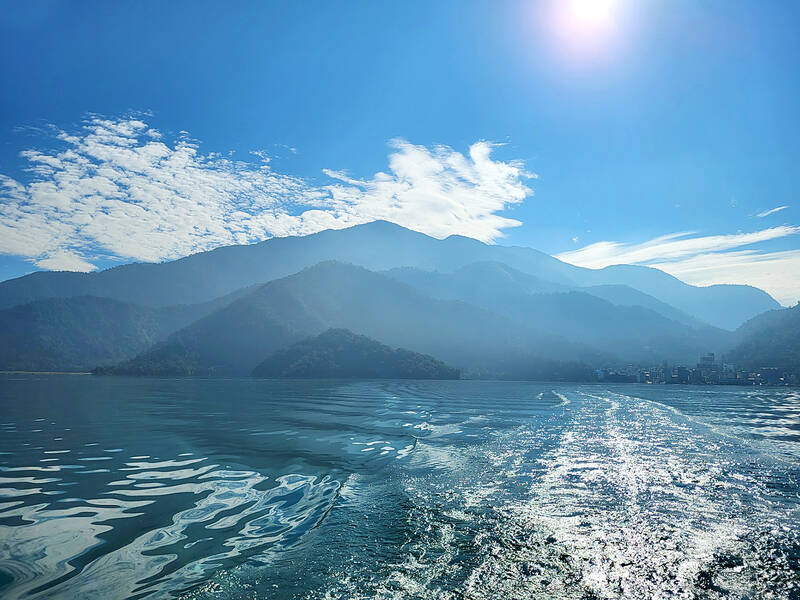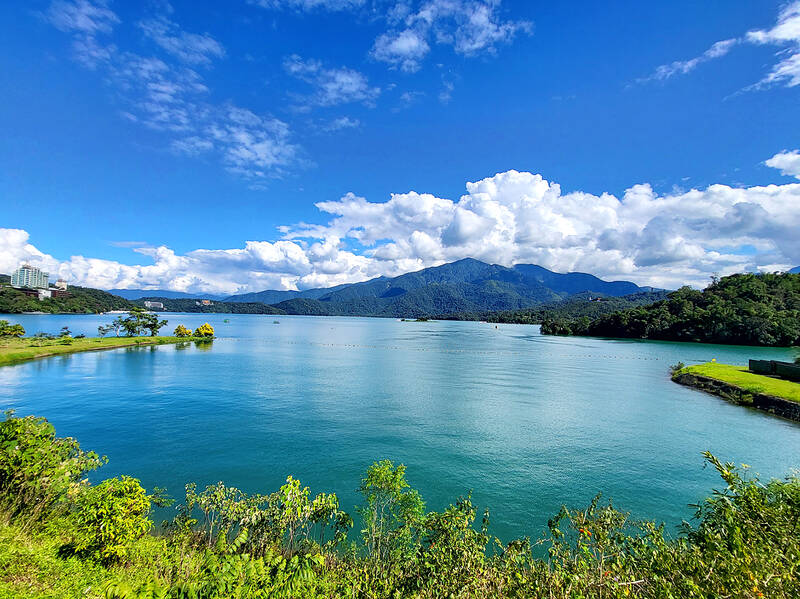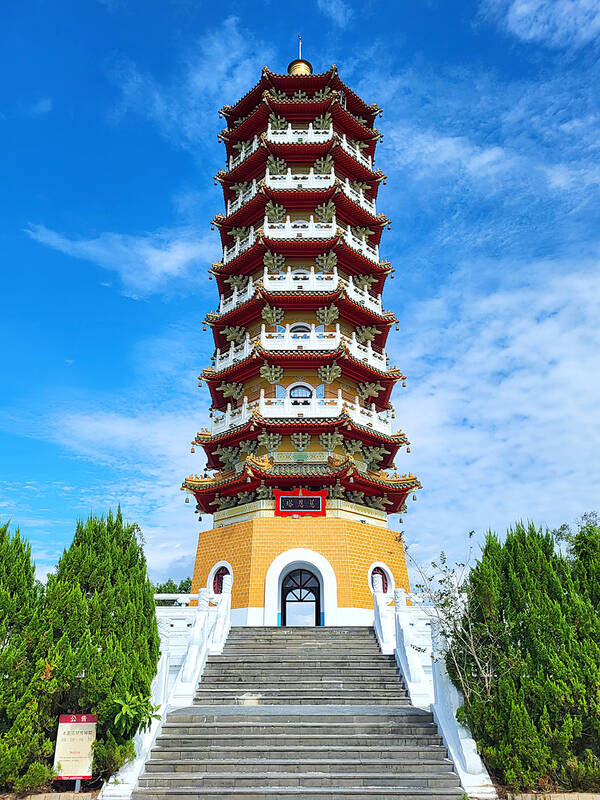Surrounding Sun Moon Lake (日月潭) there are a multitude of activities suitable for all the family that can be enjoyed on a day or weekend trip. On a recent visit, I hiked to a peak, rode a ferry across its emerald waters and a visited a pagoda with outstanding views.
Located in Nantou County’s Yuchi Township (魚池) at 748m above sea level, Sun Moon Lake it is an excellent destination in summer or winter with a year-round moderate temperature.
The lake is the largest body of water in Taiwan with a circumference of 27 kilometers. The east side of the lake resembles a sun while the west side resembles a moon — hence the name.

Photo courtesy of Mark Roche
MOUNTAIN HIGH
The lake and its surrounding countryside have been designated one of the thirteen national scenic areas in Taiwan. On a recent trip I enjoyed a walk along the Maolan Mountain Hiking Trail (貓囒山步道), which is located at the northern edge of the lake and rises to an elevation of 1,020 meters.
The Japanese colonial government established the Maolan Mountain Tea Research and Extension Station here in 1936, mainly to carry out the improvement of growing leaves for black tea.

Photo courtesy of Mark Roche
On the right side of the entrance to the trail there are several old Japanese-style buildings that houses employees for the tea research station that are made with cypress with the inside walls being of bamboo. They have been designated by the county government as an historic site.
The trees alongside the trail are Ceylon olive elaeocatpus, so-named because they are native to Sri Lanka (formerly Ceylon) and India and have fruit that resembles the olive. They are evergreen trees and the red leaves turn fiery red in the fall and winter and, when they fall, pave the ground with a red carpet that makes this a favorite place for taking wedding pictures.
The hike to the peak of the mountain, all on paved road, only takes an hour and is well worth the effort for the spectacular views of the whole area. The warm sunrise illuminates the tranquil lake water and the tea plantation that covers the mountainside, showing another side of the lake’s beauty. There is a weather station on top, which is one of the four highest in Taiwan.

Photo courtesy of Mark Roche
Maolan Mountain is also No. 49 of the Xiaobaiyue (小百岳) or “Small 100 Peaks” — specially selected “suburban mountains” that are more accessible in Taiwan’s cities and counties.
CRUISING THE LAKE
A visit to the lake wouldn’t be complete without enjoying the ferry service across it that connects the main tourist area piers of Shueishe (水社碼頭), Itathao (伊達邵碼頭) and Hsuanguang (玄光碼頭). This service, which triangulates between the three piers runs from 9am to 5pm daily and costs NT$30. Both Shueishe and Itathao have an abundance of guest houses and restaurants and either of these locations is ideal for an overnight stay.

Photo courtesy of Mark Roche
Taking the ferry across allows visitors to fully appreciate what a substantial body of water the lake is — the furthest points between the two main piers is nearly 3 kilometers in distance.
Although I didn’t do so on this occasion I would highly recommend renting a bike to enjoy the bike path that circles the lake. There is a Giant bicycle service station located at the Shueishe Pier. Rentals are reasonable and start at NT$200 per hour (e-bikes are also available).
PAGODA IN THE CLOUDS
One final place to visit is the Cien Pagoda, (慈恩塔), located just a few kilometers from either Itathao or Hsuanguang. Former president Chiang Kai-Shek (蔣介石) had it built in 1971 in an imposing traditional Chinese style in memory of his mother. The bamboo forest lining the route to the gardens at the top is the picture of tranquility.
The building in front of the pagoda was used as a rest house by Chiang and became one of his favorite places to visit.
The pagoda is 46 meters in height and sits on the 954 meter-high Shabalan Mountain (沙巴蘭山) bringing its top to an even 1,000 meters above sea level. The pagoda is an octagonal building; the three floors at the base are painted in white, while the nine floors of the main body are painted in golden red.
The view from the top offers spectacular views of Sun Moon Lake and the surrounding mountains.
Regardless of age, fitness or interests there is something for all the family to enjoy at the lake for a night or two and be sure of finish off your day at one of the many coffee shops or sipping a beer with a lake-side view.

The slashing of the government’s proposed budget by the two China-aligned parties in the legislature, the Chinese Nationalist Party (KMT) and Taiwan People’s Party (TPP), has apparently resulted in blowback from the US. On the recent junket to US President Donald Trump’s inauguration, KMT legislators reported that they were confronted by US officials and congressmen angered at the cuts to the defense budget. The United Daily News (UDN), the longtime KMT party paper, now KMT-aligned media, responded to US anger by blaming the foreign media. Its regular column, the Cold Eye Collection (冷眼集), attacked the international media last month in

On a misty evening in August 1990, two men hiking on the moors surrounding Calvine, a pretty hamlet in Perth and Kinross, claimed to have seen a giant diamond-shaped aircraft flying above them. It apparently had no clear means of propulsion and left no smoke plume; it was silent and static, as if frozen in time. Terrified, they hit the ground and scrambled for cover behind a tree. Then a Harrier fighter jet roared into view, circling the diamond as if sizing it up for a scuffle. One of the men snapped a series of photographs just before the bizarre

Feb. 10 to Feb. 16 More than three decades after penning the iconic High Green Mountains (高山青), a frail Teng Yu-ping (鄧禹平) finally visited the verdant peaks and blue streams of Alishan described in the lyrics. Often mistaken as an indigenous folk song, it was actually created in 1949 by Chinese filmmakers while shooting a scene for the movie Happenings in Alishan (阿里山風雲) in Taipei’s Beitou District (北投), recounts director Chang Ying (張英) in the 1999 book, Chang Ying’s Contributions to Taiwanese Cinema and Theater (打鑼三響包得行: 張英對台灣影劇的貢獻). The team was meant to return to China after filming, but

Power struggles are never pretty. Fortunately, Taiwan is a democracy so there is no blood in the streets, but there are volunteers collecting signatures to recall nearly half of the legislature. With the exceptions of the “September Strife” in 2013 and the Sunflower movement occupation of the Legislative Yuan and the aftermath in 2014, for 16 years the legislative and executive branches of government were relatively at peace because the ruling party also controlled the legislature. Now they are at war. The Democratic Progressive Party (DPP) holds the presidency and the Executive Yuan and the pan-blue coalition led by the